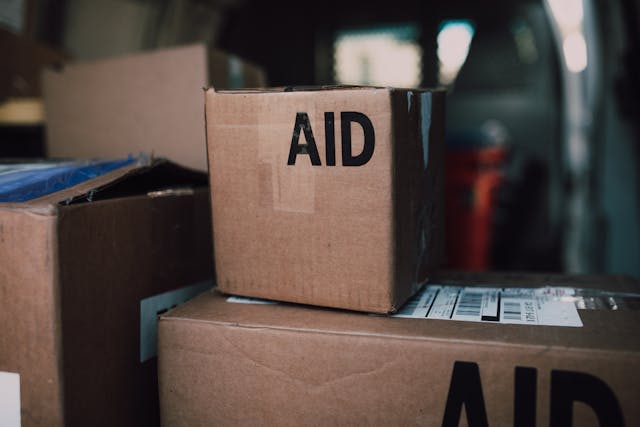Introduction
In times of crisis, logistics saves lives. Whether it’s delivering food to a flood zone, transporting medical supplies during an epidemic, or deploying shelter materials after an earthquake, the speed, coordination, and efficiency of logistics operations are critical. Emergency and disaster logistics is a specialized field that blends humanitarian principles with advanced logistics capabilities — ensuring that the right aid reaches the right place at the right time.
This course is designed to equip professionals with the essential skills to manage logistics operations during emergencies and disasters. From rapid needs assessment to last-mile delivery in complex and unstable environments, participants will learn how to build supply chains that are agile, resilient, and prepared for the unexpected.
Because in emergencies, logistics is not just about moving goods — it’s about restoring hope, dignity, and survival.

Who’s This Course For
Emergency and Disaster Logistics is designed for professionals working in humanitarian, public sector, or development contexts who are involved in disaster response planning, field operations, or emergency preparedness.
This course is ideal for:
- Humanitarian logistics and supply chain staff
- Disaster response coordinators
- NGO field and program staff
- Health logistics officers in emergencies
- Procurement and warehouse teams in crisis settings
- Government disaster management professionals
- UN agency logistics and cluster team members
- Development program managers responsible for contingency planning
Whether you’re coordinating disaster relief in-country or managing supply chains from a regional hub, this course prepares you to plan and act with speed, structure, and confidence.
Latest Trends in Emergency and Disaster Logistics
Disaster response logistics is evolving rapidly to address new types of crises, tighter donor requirements, and technological advancements. These key trends are shaping emergency and disaster logistics today:
Increasing Frequency and Complexity of Emergencies
From pandemics and climate-related disasters to conflicts and mass displacements, emergency logistics must now operate under high uncertainty, across multiple hazards, and in increasingly fragile contexts.
Localization and Community-Led Response
International responders are collaborating more closely with local actors, requiring better coordination, data sharing, and integration of local logistics capacities.
Prepositioning and Emergency Preparedness
Agencies are investing in prepositioned stocks, contingency plans, and supplier agreements to reduce response time and ensure readiness for high-probability scenarios.
Technology and Real-Time Supply Chain Visibility
Mobile apps, GPS tracking, drones, and digital platforms are improving situational awareness, needs assessment, and delivery tracking — even in low-infrastructure settings.
Donor Compliance and Accountability
Transparency and traceability of aid flows are under increased scrutiny, with stricter requirements for documentation, reporting, and real-time monitoring.
Integration of Cash-Based and In-Kind Responses
Logisticians now support hybrid response models that combine physical aid delivery with digital cash transfers and local procurement — requiring flexible logistics planning.
Learning Objectives and Outcome for the Course Sponsor
Effective emergency and disaster logistics improves response time, reduces losses, builds coordination, and ensures aid reaches those who need it most. This course strengthens the logistics readiness and capacity of humanitarian actors and their partners.
Key Learning Objectives
- Understand the Humanitarian Logistics Cycle and Core Principles
Learn the specific characteristics of emergency logistics, including speed, neutrality, coordination, and adaptability. - Plan for Logistics in Emergency Preparedness and Response
Develop contingency plans, stockpiling strategies, and supplier agreements aligned with risk scenarios. - Conduct Rapid Needs Assessments and Response Planning
Understand how to collect, analyze, and use data to inform logistics decisions in fast-moving emergency situations. - Design and Operate Emergency Supply Chains
Learn how to mobilize, transport, store, and distribute emergency relief items under challenging field conditions. - Coordinate Logistics with Local and International Stakeholders
Explore how to collaborate with clusters, national authorities, NGOs, UN agencies, and community-based responders. - Implement Last-Mile Delivery in Complex Environments
Plan for access constraints, infrastructure limitations, and security challenges in final-mile distribution. - Use Technology to Improve Visibility and Accountability
Apply tools such as GPS tracking, mobile data collection, and digital inventory systems in low-connectivity settings. - Monitor, Evaluate, and Report Logistics Performance in Emergencies
Track key metrics like delivery lead time, distribution accuracy, and supply chain continuity — and report to donors and partners.
You may also be interested in other courses in the Logistics category
Organizational Outcomes
- Faster and More Coordinated Emergency Response
Logistics teams are ready to act quickly, with clear plans, supplier networks, and transportation strategies in place. - Improved Aid Delivery and Beneficiary Satisfaction
High-quality logistics ensures that aid arrives on time, in good condition, and reaches the intended recipients. - Reduced Operational Risk and Waste
Effective planning minimizes losses from spoilage, theft, duplication, or poor coordination. - Enhanced Donor Confidence and Compliance
Transparent, well-documented supply chain processes support donor reporting and audit readiness. - Stronger Resilience and Recovery Outcomes
A robust emergency logistics system contributes to faster recovery and helps communities rebuild more effectively.

Course Methodology
This course blends technical training with simulation-based learning, case analysis, and field-focused planning. Participants will design real-world logistics plans, troubleshoot emergency scenarios, and work in teams to test their response strategies.

Core training components include:
- Emergency logistics cycle mapping and scenario planning
- Contingency planning and stock prepositioning exercises
- Simulation: managing a multi-agency logistics operation post-disaster
- Case studies: cholera outbreak response, flood relief, conflict zone logistics
- Distribution planning tools for NFI, food, and medical kits
- Mobile app demonstrations for field logistics coordination
- Cluster coordination and stakeholder mapping workshops
- KPI and reporting template development for donor accountability
The course is designed for 4–5 day in-person training or as an interactive online program. It can be tailored for natural disaster response, conflict-affected settings, or health emergencies. Participants receive planning templates, SOP examples, emergency warehouse layout guides, and monitoring dashboards.
Why It Matters in Today’s World
Disasters are increasing in frequency, scale, and complexity — and the speed and efficiency of logistics can mean the difference between life and death. Every delay, misstep, or communication gap in the supply chain can result in suffering for people already at risk.
Emergency and disaster logistics ensures that responders are not only willing to help — but fully prepared and equipped to deliver the right aid, at the right time, in the right way.
This course gives your logistics and response teams the tools to act decisively, ethically, and effectively — no matter what crisis comes next.









